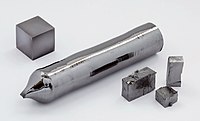
Photo from wikipedia
2D ultrafine nanomaterials today represent an emerging class of materials with very promising properties for a wide variety of applications. Biomedical fields have experienced important new achievements with technological breakthroughs… Click to show full abstract
2D ultrafine nanomaterials today represent an emerging class of materials with very promising properties for a wide variety of applications. Biomedical fields have experienced important new achievements with technological breakthroughs obtained from 2D materials with singular properties. Boron nitride nanosheets are a novel 2D layered material comprised of a hexagonal boron nitride network (BN) with interesting intrinsic properties, including resistance to oxidation, extreme mechanical hardness, good thermal conductivity, photoluminescence, and chemical inertness. Here, we investigated different methodologies for the exfoliation of BN nanosheets (BNNs), using ball milling and ultrasound processing, the latter using both an ultrasound bath and tip sonication. The best results are obtained using tip sonication, which leads to the formation of few-layered nanosheets with a narrow size distribution. Importantly, it was observed that with the addition of pluronic acid F127 to the medium, there was a significant improvement in the BN nanosheets (BNNs) production yield. Moreover, the resultant BNNs present improved stability in an aqueous solution. Cytotoxicity studies performed with HeLa cells showed the importance of taking into account the possible interferences of the nanomaterial with the selected assay. The prepared BNNs coated with pluronic presented improved cytotoxicity at concentrations up to 200 μg mL−1 with more than 90% viability after 24 h of incubation. Confocal microscopy also showed high cell internalization of the nanomaterials and their preferential biodistribution in the cell cytoplasm.
Journal Title: Biomedicines
Year Published: 2022
Link to full text (if available)
Share on Social Media: Sign Up to like & get
recommendations!